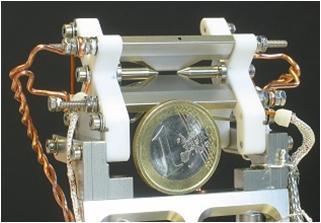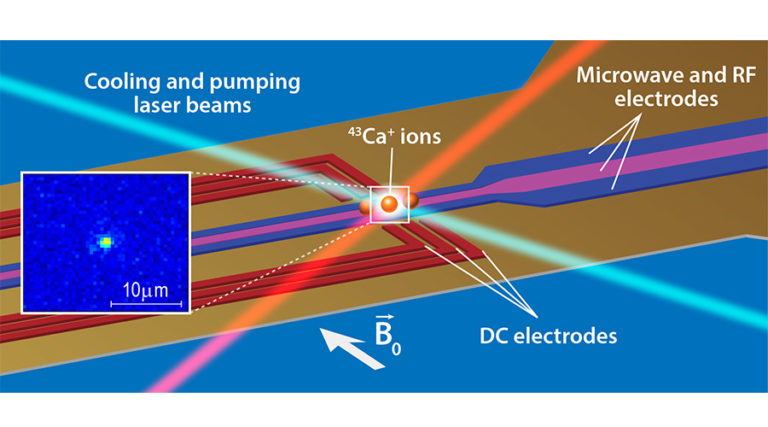Ion Trap

Share this step
Recently, we saw that the energy levels of atoms, either the simple energy levels or hyperfine splitting, can make an attractive qubit. But atoms are not usually found in isolation; they are part of materials with many atoms, whether solid, liquid or gas. Isolating and controlling individual atoms requires some thought. How can we build such a system?
Ions in a vacuum
An atom is normally electrically neutral, with the same number of electrons in orbitals as the nucleus contains. However, if we strip off (or add) one electron, the atom becomes positively charged. Such a positively (or, less commonly, negatively) charged atom is called an ion.
A positive ion will be attracted to a negatively-charged material, or can be controlled using electromagnetic fields. If we put the ion in a vacuum, we can isolate it from other atoms, and suspend it in midair (well, mid-vacuum) using electrical and magnetic fields. We call this an ion trap. An atom in an ion trap becomes a nearly completely isolated, ideal qubit.
Linear Paul trap
The first form of ion trap was invented by Wolfgang Paul, using a combination of four electrical fields, each coming from a wire or razor blade-shaped electrode. Two of the fields are unchanging while the others oscillate at radio frequencies, creating a standing wave electrical field that keeps the ion in one place. These electrodes might be a centimeter or two in length, and are arrayed in parallel a few millimeters or less apart. A side view of a trap from Innsbruck, with a one-euro coin for scale, is below.
 Figure courtesy of IQOQI Innsbruck.
Figure courtesy of IQOQI Innsbruck.
The trap is placed in a vacuum chamber (generally tens of centimeters across, though researchers are working on much smaller chambers) with fewer atoms per cubic meter than the vacuum of outer space at the altitude of the International Space Station.
This kind of trap can hold more than one ion, spaced a few microns apart in a line, where the standing waves create stationary points. Up to fourteen atoms have been trapped in this fashion and used as qubits.
The ions can be controlled by pulses of laser light fired in from outside the chamber, through a window. Different wavelengths of light are used for different purposes, such as keeping the atoms cool, executing single-qubit gates, or measuring the ions. A common way to measure the qubit is to use fluorescence, causing the atom to absorb a photon and re-emit it so that we can see the ion by the light it emits. The laser light used is tuned so that, for example, the (|1rangle) state fluoresces but the (|0rangle) state doesn’t.
Of course, we also need two-qubit gates. In ion traps, we can adjust the electromagnetic fields to cause two atoms to come together and vibrate together. If we let them vibrate for a certain period of time, the two atoms will completely exchange their states. It we let them vibrate for half that time, they will partially exchange their states, leaving the two ions entangled in a fashion that we can use to build a CNOT gate. A separate approach is to couple ions that are far apart using light emitted by one or both of them.
Surface trap
Of course, fourteen qubits is an extraordinary accomplishment, but isn’t nearly enough for running interesting quantum algorithms, let alone doing so with complicated error correction (discussed later). A newer approach known as a surface trap scales much better. A surface trap is pictured at the top of this article.
 Fig. from Jungsang Kim, “Viewpoint: Trapped Ions Make Impeccable Qubits” November 24, 2014 Physics 7, 119 https://physics.aps.org/articles/v7/119
Fig. from Jungsang Kim, “Viewpoint: Trapped Ions Make Impeccable Qubits” November 24, 2014 Physics 7, 119 https://physics.aps.org/articles/v7/119
A surface trap uses many small electrodes, tens or hundreds of microns across. Each electrode can be individually controlled to create a small electromagnetic field nearby. Set in a line, we can push and pull individual ions that are suspended in the electromagnetic field above the surface of the trap (hence the name). We can move the atoms around, bringing them together or separating them as we wish. The electrodes can be arranged so that the ions can be moved along paths in two dimensions, allowing qubits to interact with each other.
Strengths
Because the ions are suspended in a vacuum, rather than part of a solid material, they are easier to isolate from their environment than quantum dots or superconducting qubits, which are subject to decoherence caused by unwanted interactions with other electrons and nuclei in the material. Thus, trapped ion qubits have very long lifetimes, up to about a minute, orders of magnitude more than any other type of qubit. Because we can control laser light well, the gates are also very high fidelity. Ion traps are the leading platform for demonstrating quantum algorithms.
Challenges for ion traps are scale, infrastructure and timing. (Both scale and supporting infrastructure are challenges for many technologies, as we have seen.) Even the more compact surface traps are very large, compared to transistors, and the vacuum chambers are still large, so the density of qubits per cubic meter of lab space is a challenge. One group of researchers recently proposed a design for an ion trap system that would cover an entire football field with a modular ion trap system that requires an ultra-high vacuum across the entire system. Infrastructure for producing and routing many laser beams will be a demanding engineering challenge. Finally, moving ions from place to place in order to conduct two-qubit gates is time consuming, so that gates will be orders of magnitude slower than some of the solid-state systems. The advantages in fidelity may allow use of weaker error correction and offset that disadvantage, however.
イオントラップ
最近になって、単純なエネルギー準位や超微細な分裂のいずれかの原子のエネルギー準位によって、有用な量子ビットを作ることができることがわかってきました。一般に原子は(固体、液体または気体であろうと)多くの原子を有するマテリアルの一部で、孤立して存在しているわけではありません。個々の原子を個別に制御するには少し工夫が必要です。さてどうすればこのようなシステムを構築できるでしょうか?
真空中のイオン
通常時に原子は電気的に中性であり、原子番号と同じ数の電子が軌道上に存在します。しかし、電子を取り除く(または加える)とその原子は正(負)に帯電します。このような正(もしくはあまり一般的ではありませんが負)に荷電した原子はイオンと呼ばれます。
正のイオンは、負に帯電したマテリアルに引き寄せられるか、また電磁場を用いて制御することができます。イオンを真空中に置くと、それを他の原子から隔離し、電場と磁場を使って空中(真空中)に保持することができます。これをイオントラップと呼びます。イオントラップ内の原子は、ほぼ完全に孤立した理想的な量子ビットとなります。
リニアパウルトラップ
イオントラップの第1の形態は、ワイヤーまたはカミソリ状の電極からそれぞれ来る4つの電場の組み合わせを用います。これはWolfgang Paulによって考案されました。 このうち2つの電場については不変ですが、それ以外の電場は無線周波数で振動しイオンを1つの場所に保持する定在波の電界を生成します。1〜2センチの電極が数ミリ間隔で平行に配列されています。下のインスブルック大学のトラップの側面図では、大きさの比較対象として1ユーロ硬貨が並べられています。
 IQOQI Innsbruckによる画像提供
IQOQI Innsbruckによる画像提供
トラップは真空容器の中に設置して用いられます。この真空容器(一般的に数十センチですが、研究者はずっと小さな容器で作業しています)の精度は国際宇宙ステーションの高度における1立方メートル当たりの原子数よりも少ない程度です。
この種のトラップは2つ以上のイオンを保持することができます。 これらのイオンは線上に数ミクロンの間隔を空けて配置され、定在波は静止点を生成しています。 最大14個までの原子がトラップされ量子ビットとして用いられます。
イオンは容器の外部から照射されるレーザー光のパルスによって制御することができます。異なる波長の光は、原子の冷却を保ち、量子ゲートを実行したり、イオンを測定したりするなど、さまざまな目的に使用されます。一般的な量子ビット測定方法は蛍光を使って原子が光子を吸収、再放出する仕組みを利用し、放出する光によってイオンを見るという手法です。ここで使用されるレーザー光は、例えば(vert 1rangle)状態では蛍光発光、(vert0rangle)状態ではしないように調整されます。
もちろん単一のゲートだけでなく、2量子ビットゲートについても考えなければなりません。 イオントラップでは、電磁場を調整することで2つの原子を一緒に振動させることができます。 ある一定の時間2つの原子を振動させることで、互いの状態を交換します。 その半分の時間だけ振動させることで部分的に互いの状態を交換され、量子もつれの状態にすることができます。 これを2つのイオンを使ったCNOTゲートの構築に応用できます。他にも、一方または双方から放射された光を使用して離れているイオンを結合するという方法もあります。
表面トラップ
もちろん14量子ビットというのは驚異的な成果ですが、複雑なエラー訂正や興味深い量子アルゴリズムを実行するにはまだ十分とは言えません。 新たな解決策として表面トラップという優れた手法が知られています。(本稿の最上部に表面トラップの写真があります。)
 画像はJungsang Kim氏より。「トラップされたイオンは完全な量子ビットを生成する。」(2014.11.24 Physics 7, 119 https://physics.aps.org/articles/v7/119)
画像はJungsang Kim氏より。「トラップされたイオンは完全な量子ビットを生成する。」(2014.11.24 Physics 7, 119 https://physics.aps.org/articles/v7/119)
表面トラップでは数十ミクロンから数百ミクロンの小さな電極を多数使用し、各電極を個別に制御することで近くに小さな電磁場を作り出すことができます。 そしてトラップの表面上の電磁界に浮遊している個々のイオンを操作することができ、くっつけたり離したりと思い通りに動かすことができます。電極を配置を操作することで、イオンが2次元上の経路に沿った移動を可能とし、量子ビット同士の相互作用を実現します。
強度
イオンは何らかの固体の一部ではなく真空中に浮遊しています。 このため、量子ドットや超伝導量子ビットなど他の電子や核との望ましくない相互作用によってデコヒーレンスを引き起こしてしまう系よりも、容易に周りの環境から隔離できます。 従って、トラップされたイオン量子ビットは非常に長い寿命を有し(約1分にものぼる)、他のタイプの量子ビットより大きなオーダーになります。 レーザー光はかなり精密に制御することができるので、ゲートも非常に高精度で実現できます。 すなわちイオントラップは量子アルゴリズムを実証するための最先端のプラットフォームといえるのです。
一方で考えられる課題としてはその規模的問題、インフラ、時間的問題が挙げられます。 (特に規模とサポートインフラストラクチャは多くの技術における課題になっています。)今のところ、どんなにコンパクトな表面トラップであったとしても、トランジスタに比べればまだまだ大きいうえに真空容器も依然として大きいため、研究室において1立方メートルあたりの量子ビット密度をいかに大きくするかという問題はかなり重要です。
ある研究者グループは最近、システム全体にわたって超高真空を必要とするモジュール式イオントラップシステムを用い、サッカー場全体をカバーするほどのサイズのイオントラップシステムの設計を提案しました。 多くのレーザービームを生成・ルーティングさせる必要があり、その点においてインフラはかなり難しい技術的課題になります。 また、2量子ビットゲートの実行に応じてイオンを移動させるのは時間がかかります。そのためゲート実行に一部の個体素子系よりも数桁長い時間がかかります。ただしフィデリティの高さにより誤り訂正は簡単になるため、それらの欠点を相殺することができます。
Share this

Reach your personal and professional goals
Unlock access to hundreds of expert online courses and degrees from top universities and educators to gain accredited qualifications and professional CV-building certificates.
Join over 18 million learners to launch, switch or build upon your career, all at your own pace, across a wide range of topic areas.
Register to receive updates
-
Create an account to receive our newsletter, course recommendations and promotions.
Register for free








